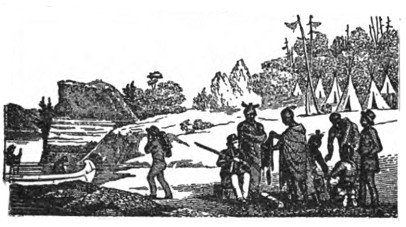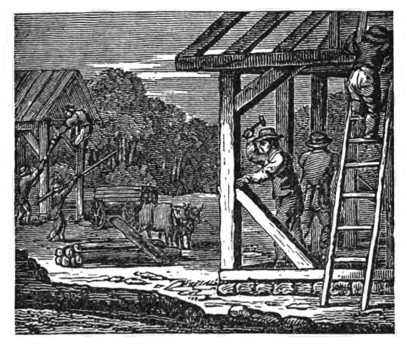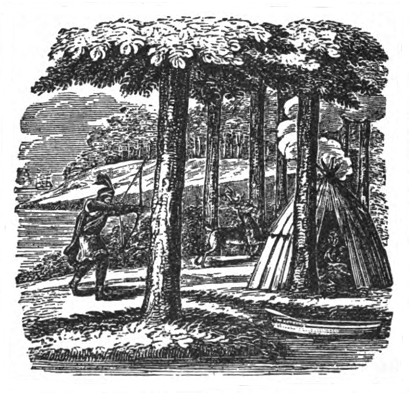| Web
and Book
design,
Copyright, Kellscraft Studio 1999-2009 (Return to Web Text-ures) |
 (HOME)
|
|
An
Unredeemed Captive
Chapter I Of
the Settlement of Deerfield — John Eliot and the Indians —
The
Purchase of the Deerfield Grant from the Savages by Major Pynchon —
The First Minister and the First Tavern
THE old French and Indian wars began in the year 1689 and continued with only two or three short intermissions of peace until 1763. During all this long period of seventy-four years the weakling colonies of New England were constantly harassed by raiding parties of the enemy; and it is probable no English town in the colonies suffered more in the struggle for race supremacy from the depredations of the French and Indians than Old Deerfield. It was one of the New England outposts and its position in the Connecticut valley made it easy of access by one of the natural routes from the north. Once it was all but wiped out, and the inhabitants of the region, singly or several at a time, continued to be shot or captured by the northern enemy down to 1758. But this does not include all its troubles from savage foes, for its first experience of war dated back to the time of the Indian rising under King Philip.  Deerfield was an offshoot of Dedham, one of the old towns a few miles out from Boston. This connection with Ded ham came about indirectly through John Eliot, the famous apostle to the Indians. The conversion of the natives was early an object of solicitude among the almost morbidly religious Puritans. But the obstacles were such that the work was not begun in earnest till 1644. It was in the autumn of that year that John Eliot, the scholarly pastor of the church at Roxbury, preached his first sermon in the Indian tongue in a wigwam on Nonantum Hill. From this time to the end of his life his labors for the Indians were unflagging. He soon saw that as long as the Indians remained in their savage state, living in scattered groups and frequently moving from place to place, the results he accomplished would be transient and uncertain, and he says he "looked for some spot somewhat remote from the English, where the Word might be constantly taught, and government constantly exercised, means of good subsistence provided," etc. Such a site he found at Natick. The General Court approved the scheme and the town of Dedham turned over 2000 acres of land to the Indians. The bounds for the Indian plantation at Natick were duly laid out, but, just as in all the history of the whites' dealings with the natives when they own land the whites covet, the years following were noisy with complaints of "affronts offered" by the savages and disputes about the lines of separation. In the end, to compensate the Dedhamites for their supposed losses and sufferings at the hands of their Indian neighbors, the General Court granted them 8000 acres of land which they were to pick out wherever they chose in the yet unsettled parts of the colony. The selectmen, to whom the matter was turned over, looked about and presently "heard of a considerable tract of good land that might be answerable to the town's expectation, about ten or twelve miles north from Hadley;" and they advised that the town should take possession "with all convenient speed, before any other granter enter upon it and prevent us." In 1665 the bounds of the grant had been determined and the next thing to be done was to go through the farce of purchasing it from the Indians. All the land occupied by our New England settlers was bought from the Indians, but the early pioneers never let sentiment interfere with business — they bought as cheaply as they could, independent of the real worth of their purchases. For instance, all the fertile lowlands from Suffield to Northfield were obtained from the natives for a few great coats and some hundred fathoms of wampum. The Indians were as children in the hands of the Puritans when it came to business.  Major
John Pynchon of Springfield, in his double capacity of magistrate and
trader, had much to do with local Indians and effected nearly every
important purchase from them. The Sachems of the valley kept a
running account at Pynchon's shop, and to offset this ac count they
pledged their lands in payment. Here are the items of a bill against
Umpachala, the Norwottuck Sachem, in payment of which the Indian gave
Pynchon a deed of the town of Hadley:
The total is $64. It is no wonder if the Indians on reflection wanted to scalp such traders and their associates. Technically there was no injustice, but advantage was taken of the fact that the red man, with his simple wants and characteristic lack of foresight, was no match for the ambition and shrewdness of the civilized white. It was to Major Pynchon that the Dedham authorities looked to get them a clear title to their tract of land from the original owners. This he did with his usual economy, only reserving to the natives the right "of fishing in the waters and rivers, and free liberty to hunt deer and other wild creatures, and to gather walnuts, chestnuts and other nuts and things on the commons." The Deerfield grant was duly divided among the Dedham townspeople and in a few cases the new owners emigrated to their wilderness property. In the main, however, they held the land as a speculation, just as a person might now possess himself of suburban lots to be sold when he saw a chance to make a satisfactory profit. Two Hatfield men were the first to put up their rude abodes in the forests that then covered the site of the new town. This was in the early summer of 1670. Others followed, and in a few years the settlement had grown to quite a village, the houses dotted along on a north and south line in almost exactly the same place and manner as in the town of the present.  In 1673, the General Court granted the Deerfield settlers such an addition to the original 8000 acres as should make them a township seven miles square, provided that within three years they should settle "an able and orthodox minister." The frontier citizens did not await the time limit; for that same year Mr. Samuel Mather began his labors as the first minister of Deerfield. He was then only twenty-two years old, a recent graduate of Harvard College and a near relative of those two New England notables, Increase and Cotton Mather. With the church thus established, the only thing that remained to fully round out the town life was a tavern. This came the year following, when Moses Crafts "was licensed to keep an Ordinary and to sell wines and strong liquors for one year, provided he kept good order in his house." Drinking was far more general in those days than now and the alehouse was inevitable, but it is to be noted that the church preceded it. In the story of our western country it is a different matter. There the saloon has always marched in the vanguard of civilization. At first the town was known by its Indian name of Pocumtuck, but the abundance of deer in its woodlands suggested, and in time gave, its present name acceptance. The savages still hunted, trapped and fished in the valley, they bartered at the tavern or made small exchanges of mats and baskets for civilized wares at the village housedoors, and their wigwams were to be seen along the streamsides as of old. There was peace in the valley and the new settlers were beginning to conquer comfort and prosperity.  |